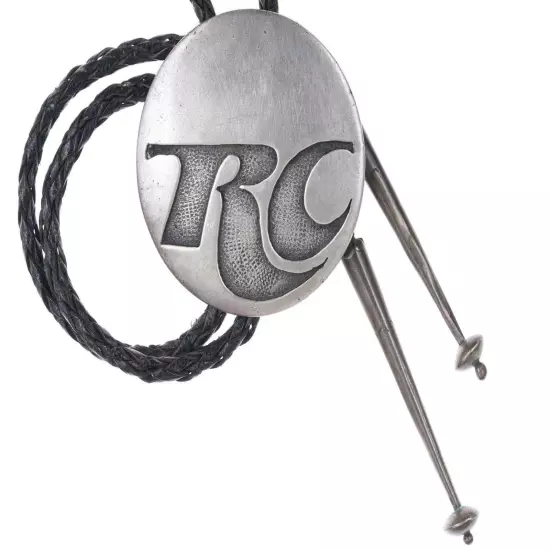1950's Frank Patania Sr(1899-1964) Modernist southwestern Sterling RC Bolo
tie.2" wide bolo slide 37.7 grams with no issues. Rare possibly one of a
kind, FrankPatania and his studio did a lot of custom pieces. This is
obviously the RC Colalogo but at this point I have no way of knowing if it
were made for say acompany exec or someone with the initials RC. Shouldn't
really matter, it's veryAll precious metals are tested and
guaranteed, any Native American jewelryreferred to as Silver or Sterling is
guaranteed to be a minimum of 90% (coin)silver and possibly higher content.
Anything marked is guaranteed to be whatit's marked, most bracelets are
photographed on a 6" wrist (non hairy), ringsphotographed on the
appropriate sized finger when possible. With bracelets ifthe measurement is
not given in the description then inside circumference isshown where the
metal meets the number on the the cloth tape measure.Frank Patania Sr.
immigrated to New York City in 1908. Child labor laws kept theyoung man
from working as a craftsman, but after World War I he was old enoughto be
hired as a designer for an important jewelry firm. In 1924 he
contractedtuberculosis, and the firm sent him to a sanatorium in Santa Fe,
New Mexico.Patania was seduced by the active art colony and healthy
climate, and chose toremain in the Southwest even after his health
improved. His work reflects bothhis European training and his exposure to
Pueblo and Navajo jewelry.The legacy left by Frank Patania, Sr. came
from the integration of twodistinctly different traditions-one European,
and the other Native American. Onthe one hand, Frank Sr. drew from a long
history of Italian creative spirit,combining technical expertise and
artistic imagination. He instilled in hisfamily the Italian commitment to
fine craftsmanship, as well as the Italiancustom of family corporate
bonding.This uniquely Italian tradition can be traced back as far as
the Renaissance,and provides a structure in which each member of an artisan
family has a job toperform that contributes to the family enterprise. This
familial check andbalance system has been a powerful asset to the Patania
family's continuedstandard of excellence through the years. But Frank Sr.'s
style was drasticallytransformed when he was introduced to the work of
southwest Native AmericanHis inspiration was
multi-faceted; he began to work in a new medium-silver andturquoise-as well
as in increased scale, and using new techniques. Thesuccessful marriage of
these two disparate traditions has become the foundationupon which each
generation has maintained the tradition of excellence incraftsmanship and
design that has come to be known as the "Patania Thunderbird"style.
tie.2" wide bolo slide 37.7 grams with no issues. Rare possibly one of a
kind, FrankPatania and his studio did a lot of custom pieces. This is
obviously the RC Colalogo but at this point I have no way of knowing if it
were made for say acompany exec or someone with the initials RC. Shouldn't
really matter, it's veryAll precious metals are tested and
guaranteed, any Native American jewelryreferred to as Silver or Sterling is
guaranteed to be a minimum of 90% (coin)silver and possibly higher content.
Anything marked is guaranteed to be whatit's marked, most bracelets are
photographed on a 6" wrist (non hairy), ringsphotographed on the
appropriate sized finger when possible. With bracelets ifthe measurement is
not given in the description then inside circumference isshown where the
metal meets the number on the the cloth tape measure.Frank Patania Sr.
immigrated to New York City in 1908. Child labor laws kept theyoung man
from working as a craftsman, but after World War I he was old enoughto be
hired as a designer for an important jewelry firm. In 1924 he
contractedtuberculosis, and the firm sent him to a sanatorium in Santa Fe,
New Mexico.Patania was seduced by the active art colony and healthy
climate, and chose toremain in the Southwest even after his health
improved. His work reflects bothhis European training and his exposure to
Pueblo and Navajo jewelry.The legacy left by Frank Patania, Sr. came
from the integration of twodistinctly different traditions-one European,
and the other Native American. Onthe one hand, Frank Sr. drew from a long
history of Italian creative spirit,combining technical expertise and
artistic imagination. He instilled in hisfamily the Italian commitment to
fine craftsmanship, as well as the Italiancustom of family corporate
bonding.This uniquely Italian tradition can be traced back as far as
the Renaissance,and provides a structure in which each member of an artisan
family has a job toperform that contributes to the family enterprise. This
familial check andbalance system has been a powerful asset to the Patania
family's continuedstandard of excellence through the years. But Frank Sr.'s
style was drasticallytransformed when he was introduced to the work of
southwest Native AmericanHis inspiration was
multi-faceted; he began to work in a new medium-silver andturquoise-as well
as in increased scale, and using new techniques. Thesuccessful marriage of
these two disparate traditions has become the foundationupon which each
generation has maintained the tradition of excellence incraftsmanship and
design that has come to be known as the "Patania Thunderbird"style.
| Brand | Does Not Apply |
|---|


